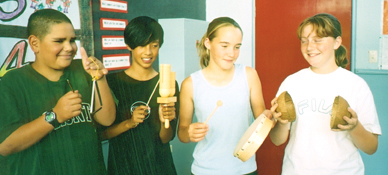![]() THE
ROLE OF GROUP DYNAMICS ON MUSIC TASK PERFORMANCE
THE
ROLE OF GROUP DYNAMICS ON MUSIC TASK PERFORMANCE
![]()
Peh
Siew Hoon
This
study explored the extent to which various facets of group dynamics
influenced student performance on the 1996 NEMP assessment music
team tasks, in which groups of four students worked collaboratively
to create music and respond to music. |

Videotapes,
randomly selected from the 1996 NEMP sampled population, were viewed.
The tapes (68 for Year 4 and 67 for Year 8) were analysed using a structured
checklist containing items pertaining to five factors deemed to affect
the dynamics of the music groups: peers, gender, musical ability, the
spatial arrangement of each group, and the influence of the teacher-administrator.
| •
Overall, group dynamics played a significant part in determining the
results of the NEMP music tasks. However, this influence varied from
group to group and from task to task. • Peers affected the actions and the musical responses of the group members. Most students tended to follow one another’s movements in group tasks requiring them to respond to the music with physical movements (e.g., ‘Musical Sticks’ and ‘Team Machine’). In team tasks involving percussion instruments, such as ‘Animal Parade’ and ‘Beat and Rhythm’, students were more intent on individually exploring the sounds produced by the percussion instruments than watching the actions of their peers. • The extent to which the gender composition of a group influenced each child’s task performance depended on the age of the child and the nature of the activity. |
•
Spatial factors, such as the number of students in a group or the
seating arrangements, did affect the actions and musical responses
of the group. Year 4 students were more likely than Year 8 students
to sit in close proximity with group members with whom they felt comfortable. • A leader emerged from most of the groups. Leaders were not always the most musical children but were almost always the most aggressive or charismatic. Some were good musical leaders and some were not. • The teacher-administrator’s attitudes and mannerisms, the level of help this person gave the students in the performance of their tasks, and his or her degree of adherence to task instructions also influenced group dynamics and, in turn, student performance. |
![]()
•
Some music tasks should perhaps be administered on an individual basis.
• Tasks need to be re-evaluated in terms of their appropriateness
for each age group.
• When administering standardised tasks, it is important that teacher-administrators
consciously strive to minimise the influence they can exert on group dynamics
in general and individual student task performance in particular.
• Students need to be allowed to explore the full potential of their
musicality and instruments. Appropriate lengths of time need to be determined
for students to work out answers on their own before being given prompts
or help.